
NEWS
NTP Company and Customer Stories
Penta & DAD
From Around the World
AX32 Makes Ambisonics Dreams Come True at The Royal Danish Academy of Music
Thanks to new audio formats such as Dolby Atmos, Auro 3D and Ambisonics, immersive audio has become something of a buzzword lately. But while the individual formats may be new, the idea of immersive sound is far from new…

We met with Jesper Andersen, Associate Professor and Head of Tonmeister Studies, at the Royal Danish Academy of Music in Copenhagen, Denmark, to learn more about a brand-new concert hall with a very immersive twist and some AX32-magic at the core. The Royal Danish Academy of Music is all about classical music, and it was in this context that Jesper Andersen shared with us that the idea of having multiple sources playing from different locations has been around in classical music for decades – even centuries!
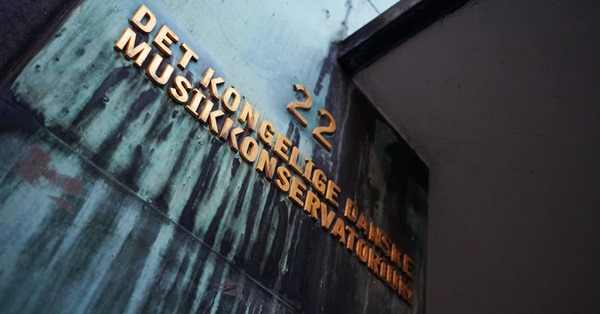 “In contemporary classical music that often includes one or more electronic elements, composers have experimented with placing speakers behind the audience or on the sides as far back as the 50’s, 60’s and 70’s,” Jesper Andersen says.
“In contemporary classical music that often includes one or more electronic elements, composers have experimented with placing speakers behind the audience or on the sides as far back as the 50’s, 60’s and 70’s,” Jesper Andersen says.
“In fact, there are examples in music history, dating back as far as the 17th century, about notes in the sheets that for example would place a musician behind the audience. So, the very idea of sound not just coming from a single point – or at least ‘one side’ – is far from new.”
We guess that unless there were also experiments with ceiling speakers or musicians on a balcony, these examples are to be considered ‘surround sound’ ideas rather than immersive, but it certainly gives a natural explanation to why the Royal Danish Academy of Music were interested in exploring a truly immersive setup in a room that is dedicated to exactly that.
Another, more practical, reason is that the Royal Danish Academy of Music actually did host immersive concerts regularly in the past. But without having a permanent setup for this, they had to rent a lot of speakers and set everything up – and tear it down again – several times a year.
48 Audio Channels for a Massive Ambisonics System
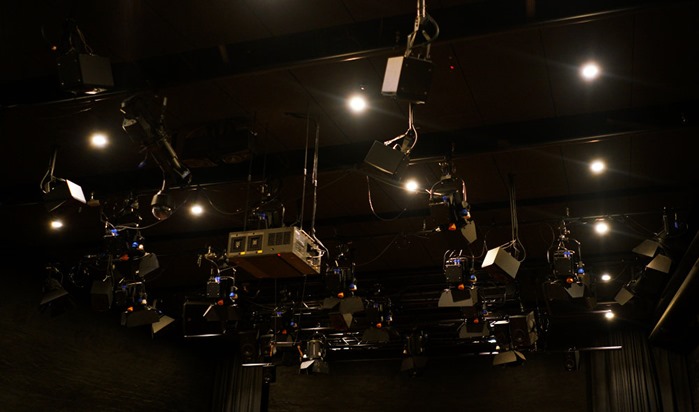 In total, the Ambisonics system in the immersive hall comprises a staggering 48 channels with 44 speakers (Dynaudio LYD) and 4 subwoofers (Dynaudio 18S). The speakers are installed to form a hemisphere as accurately as possible.
In total, the Ambisonics system in the immersive hall comprises a staggering 48 channels with 44 speakers (Dynaudio LYD) and 4 subwoofers (Dynaudio 18S). The speakers are installed to form a hemisphere as accurately as possible.
“The idea behind Ambisonics is that the speakers should form a hemisphere and ideally place the listener right in the middle.
And if you record and mix in this format and encode it, the Ambisonics file is able to be played back through another Ambisonics system that may be smaller or larger, as positioning is embedded with a hemisphere in mind.
But the format is not ‘locked’, which means that we can also playback recordings mixed in e.g. Dolby Atmos. For instance, at the grand opening of the hall, we played a classical recording where the musicians were moving around during the performance. It was mixed in Atmos at the National Film School of Denmark’s cinema mixing stage here in Copenhagen, but was easily adapted to our Ambisonics hemisphere, as it was rendered to an Ambisonics file. In other words, it is absolutely possible to translate between these two immersive audio formats.”
A Near-Perfect Hemisphere Gets Closer with SPQ
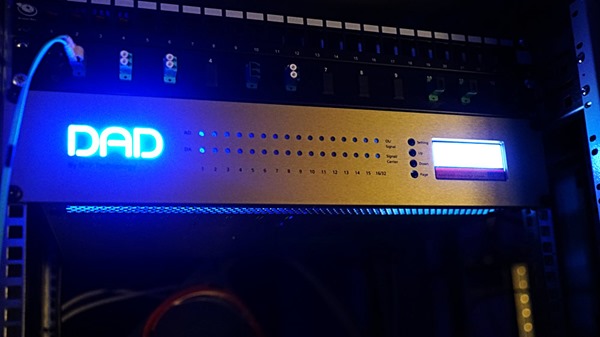 As mentioned, in the ideal world, the speakers would form a perfect hemisphere, but that was very difficult to achieve. For instance, the hall is rectangular, which means that the speakers on the sides are actually too close to the listeners compared to the speakers at the front and rear. But luckily, there was a solution to this problem – our SPQ speaker management card for the AX32 that was already chosen to handle all of the D/A conversion and audio-routing.
As mentioned, in the ideal world, the speakers would form a perfect hemisphere, but that was very difficult to achieve. For instance, the hall is rectangular, which means that the speakers on the sides are actually too close to the listeners compared to the speakers at the front and rear. But luckily, there was a solution to this problem – our SPQ speaker management card for the AX32 that was already chosen to handle all of the D/A conversion and audio-routing.
“We used a measurement microphone and determined the distance to the speaker that was the farthest away, and then we added delay to the rest in order to emulate a perfect circle in each speaker plane.
The Ambisonics format is not about absolute distance, but more the relative relationship between the speakers – or in other words, the geometry is key rather than the size of the hemisphere.
Using the AX32 with the SPQ card brought us so much closer to the perfect hemisphere, as we measured and compensated each channel to deliver within a 1-millisecond margin. The AX32 / SPQ combo was an absolute genius solution to this problem!”
Triple Up on SPQ Purposes: Delay, Volume & EQ
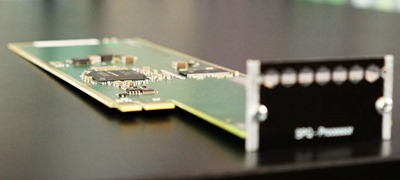 Apart from using the SPQ card for shaping the hemisphere, it was also used for two other purposes: “After solving the geometry issue by adding delay to the channels that needed to be farther away, we did another round of measuring each channel – this time with a view to match the volume at the center-listening position, which also worked out beautifully.
Apart from using the SPQ card for shaping the hemisphere, it was also used for two other purposes: “After solving the geometry issue by adding delay to the channels that needed to be farther away, we did another round of measuring each channel – this time with a view to match the volume at the center-listening position, which also worked out beautifully.
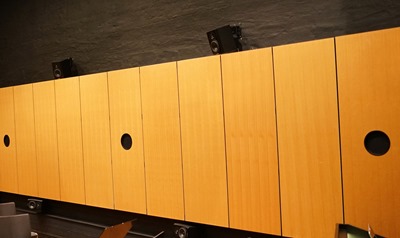 And as third round of adjusting, we applied room correction with the EQ’s on the SPQ card. Some of the speakers are inside cabinets and there is cloth in front of them, while others are installed near corners.
And as third round of adjusting, we applied room correction with the EQ’s on the SPQ card. Some of the speakers are inside cabinets and there is cloth in front of them, while others are installed near corners.
However, we did not use calibration software in this case, as we decided to do it entirely by ear. Yes, it will definitely add a subjective element to the result, but we knew what sound we were looking for and we are very happy with the result.
Finally, it should be mentioned that we did do a second round of calibrating the volume again, as the applied EQ obviously affected the original volume calibration.”
Research Ideas Occur
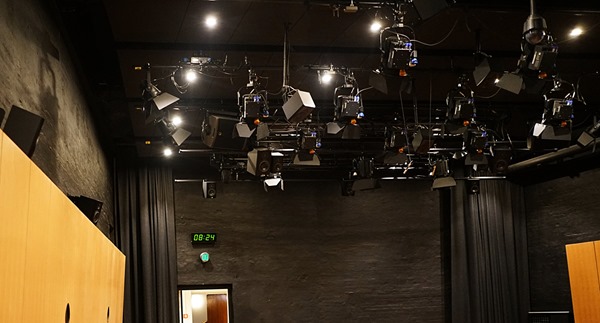 During the process of fine-tuning the absolute top and center point of the hemisphere, the two top speakers were delayed a bit to place them higher, as they are only half a meter above the second layer, and from that point and down there is one meter vertically between each layer of speakers.
During the process of fine-tuning the absolute top and center point of the hemisphere, the two top speakers were delayed a bit to place them higher, as they are only half a meter above the second layer, and from that point and down there is one meter vertically between each layer of speakers.
“To place the two top speakers half a meter higher, it was simply a matter of using the SPQ card to delay them accordingly, but we also experimented with placing them even higher, and also to isolate them, as having sound coming toward you directly above your head is a phenomenon that still needs to be researched more thoroughly researched and experimented with.
The thing is that we can determine the direction of sound, as it hits one of our ears first, and then there will be a change in volume as well as time when it reaches the other ear. But when it comes from precisely above you it will travel down your head and reach both ears at the exact same time and at the exact same volume. This is also the case for sounds coming from front and rear. The shape of the outer ear filter the sound to give cues about the front/rear-localization, but for sounds from above it is quite hard to localize precisely.”
(Almost) All Access
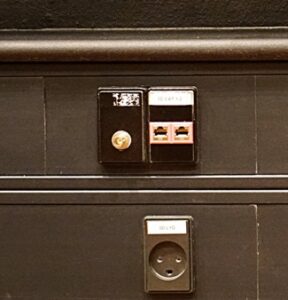 “We give the students easy access, but they can not change anything in the playback system on their own. We consider the SPQ card and the many options it provides a part of the installation that is not to be altered unless we decide to do so.
“We give the students easy access, but they can not change anything in the playback system on their own. We consider the SPQ card and the many options it provides a part of the installation that is not to be altered unless we decide to do so.
Similarly, the switches on the back of each speaker that can tailor the sound are no to be changed – all of that is part of how we decided that the system should sound fundamentally.
But we definitely wanted the students to be able to connect directly from Pro Tools, Pyramix, Reaper, Logic Pro or whatever DAW they prefer to use. That was important to us.”
To facilitate this easy access to the system, there is a socket in the wall that connects directly to the AX32 in the room next door. It has MADI and Dante inputs, which means that the students can hook up their own laptops or digital mixers easily and work on their productions right then and there.
Room for Experimentation and Learning
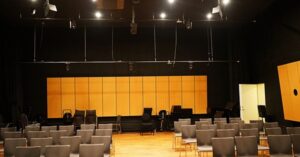 The four subwoofers are not a fixed part of the installation, which was partly decided with an educational view in mind.
The four subwoofers are not a fixed part of the installation, which was partly decided with an educational view in mind.
“Had the installation been in a concert hall, it might have made sense to fix the subs in the corners – maybe even hanging them from the ceiling.
You know, it is said that the very low frequencies are not placed as precisely by the human ear as higher frequencies. While this is true, it does make a slight difference where they are placed, and we would like to make it possible to experiment with this aspect.
It makes total sense for our Tonmeister students to be able to try out different subwoofer positions and also test unusual settings such as four subs right in the center, below specific chairs or maybe placed on top of each other to form a low-end tower.
Another cool thing we have been trying was to record in our large concert hall and then recreate that experience in this room. In short, it worked out beautifully, and if you were sitting e.g. at the front in the right side at the concert and took the same seat in here, the experience would be very similar.
And the other way around, we have also experimented with music and sounds that are meant to be experienced while moving around. For these occasions, there are no chairs that keep the audience in a permanent listening position, but rather they are naturally encouraged to walk around and experience what it sounds like over here, on that side or in a corner.”
Add-On Stereo Capability
 As mentioned, the system has 48 audio channels, but the actual Ambisonics dome is ‘only’ taking up 38 channels – plus 4 channels for the subwoofers.
As mentioned, the system has 48 audio channels, but the actual Ambisonics dome is ‘only’ taking up 38 channels – plus 4 channels for the subwoofers.
The speakers in the dome are Dynaudio LYD 5 with 5” woofers and 1” tweeters, but an extra pair of LYD 8 speakers with 8” woofers and 1” tweeters has been added to make sure that the system will be able to playback stereo content in the best way possible.
“You could choose to use two of the LYD 5 speakers, which is part of the Ambisonics system, to be the Left and Right speakers in a stereo setup, but we found that it was not an ideal solution.
Therefore, we added two slightly larger LYD 8 speakers, which you could also use within the Ambisonics system, as all speakers are networked in the AX32 – but we usually don’t do that.
In fact, since we even had two audio channels to spare, we added another pair of LYD 8 speakers that are not installed permanently, but can be brought in along with one or more subwoofers to set up a temporary stereo system where the Left and Right channels are not necessarily coming from the ceiling.
The way the AX32 gathers and routes all of the audio channels is just so flexible that it leaves us with a lot of options on our hands, which – as you can see – is great for many different purposes.”
The Sweet Sound of Silence
 “One other thing I would like to point out about this system is that the audio converters are dead silent. And considering that we have over 40 speakers turned on at full volume and the gain on the converters is also at its maximum setting, this is quite astonishing.
“One other thing I would like to point out about this system is that the audio converters are dead silent. And considering that we have over 40 speakers turned on at full volume and the gain on the converters is also at its maximum setting, this is quite astonishing.
We built a much smaller version of this system, using another converter and also cheaper speakers, and there were just compromises to be made. We had to turn down the converters and live with a certain noise floor. But now, we have it just the way we dreamed of without any noise whatsoever.
The only noise you may hear from time to time in this room is when the PA system, which is not part of the dome, is turned on or when the small surveillance camera in the ceiling is moving.”
And on that note, we were ready to wrap up our visit at The Royal Danish Academy of Music, but then a true Steve Jobs moment occurred, as Jesper Andersen said: “Just one more thing… Do you have time to see our recording studio?”
As it turned out, the AX32 in the Ambisonics system was not the only one in the building. In fact, they use two AX32’s in their impressive recording studio. Surely, we had time for that! But that is another story, which we will share with you soon. So, to be continued…
In the meantime, please watch a video that our friends at Dynaudio created on the day of the grand opening of the immersive hall at The Royal Danish Academy of Music:
About the Royal Danish Academy of Music
The Royal Danish Academy of Music is a power centre in the classical music world, representing the highest international level and compares to and cooperates with a number of the foremost music academies in the world. The academy offers study programmes within music and music pedagogy at the highest level, taught by a corps of teachers, numbering several of the greatest names in music, including many international capacities affiliated as guest professors. The study environment is very international and is characterized by a healthy competition accentuated interaction between the students, Danish as well as international.
The academy offers a wide selection of study programmes at bachelor, master and advanced postgraduate soloist level aiming at employment as musicians, organists, composers, music teachers, tonmeisters or other employment possibilities within the music world. The advanced postgraduate programmes improve the students’ level to the highest possible as soloists, opera singers, composers or conductors.
